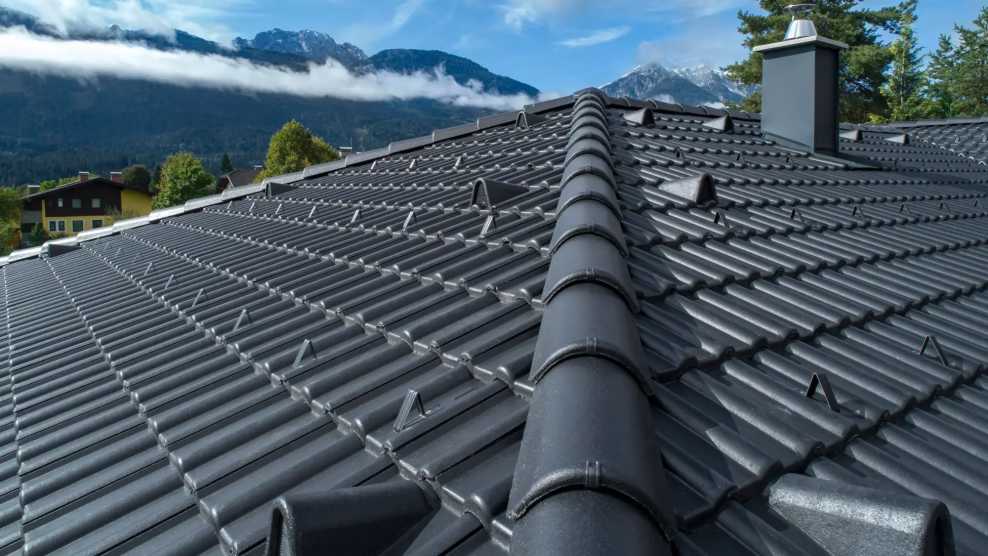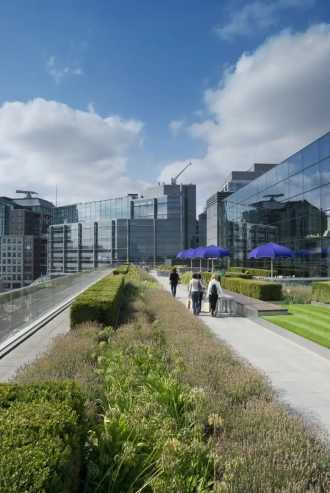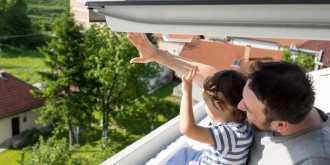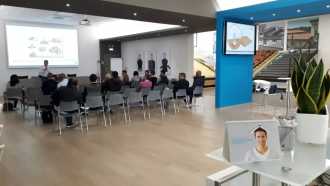Our country pages
Africa
Europe
Search
Roof tiles as first choice for sustainable building

How sustainable construction changes in cities
The fact that the world is changing due to climate change is clear for all to see: every day the media is full of unsettling news stories of extreme weather events, exceedingly high smog rates, shrinking millennial glaciers and many other extreme events. It is clear that these changes are the result of the technological, economic, social and territorial developments brought about by the industrial revolution: emissions, the greenhouse effect, acid rain and other phenomena have long-standing and alarming environmental repercussions.
It is a global phenomenon but it particularly affects certain geographical areas: poorer populations that often are concentrated in areas already affected by adverse weather conditions. However, the consequences for those who live in the cities can also have health repercussions, something that was severely put to the test during the recent pandemic.

Jump to section
The Urban Heat Island (UHI) effect, which affects urban and metropolitan areas, especially in the Mediterranean, has long been known and is scientifically documented. This occurs when an urban or metropolitan area is significantly warmer than outlying areas at any given time.
The heat island effect can manifest in two ways:
superficial: the rise in surface temperature that occurs due to exposure to solar radiation (depending on the degree of absorption, the properties of the materials, etc.)
atmospheric: a temperature rise of +2°- +3° (although scientists estimate that this will rise to +5° by 2050) in urban areas compared with surrounding rural areas, particularly noticeable during the night when surfaces release the heat absorbed during the day.
This is due to various factors that are specific to each individual place:
the urban configuration (depending on the level of urban density and presence of high-rise buildings in the area)
solar exposure
typical weather conditions (the amount of wind, rainfall, etc.)
the presence and extent of urban green spaces
the concentration of the main business activities
the quality of the materials that characterise the same.
The latter factors can play a key role in improving the situation since they react to natural phenomena (humidity, air, irradiation, etc.) and can condition the local microclimate. Scientists are conducting a great deal of research into these phenomena and are focusing in particular on monitoring events and devising strategies aimed at containing emissions and mitigating the effects. The initial goal is to hold the increase in the global average temperature to well below 2°C above pre-industrial levels, as established in the Paris Agreement of 2015, and to reach the year 2050 with net greenhouse gas emissions close to zero.
We frequently hear talk of resilience, understood as the capacity to adapt to change. When talking about systems (ecological and urban), this refers to the system's capacity to repair itself and return to its initial state following disruptive action and the consequent modification of its original state.
Looking at cities today, such a goal seems difficult to achieve. It is, however, certainly possible to avoid worsening the situation and for this reason, many Italian cities have adopted programmes aimed at:
updating plans and measures for reducing greenhouse gas emissions
increasing the production and use of renewables
devising energy-saving strategies for public and private buildings
rethinking mobility from a sustainability perspective
supporting the circular economy
monitoring and measuring changes
setting up early-warning systems and emergency plans to manage risks and reduce the risk exposure of the population
assessing the correlations between changes, health and health costs
focusing on green urban spaces
investing in urban development, the proper management and use of the soil, water resources, buildings and infrastructure.
Resilience needs therefore to be planned: a principle that is valid when referring to the quality of cities, their parts and buildings.
In the cities, the strategies to be adopted should essentially aim to reduce waterproofing and new land consumption, control rainwater runoff and monitor urban drainage and the water network, with adequate infrastructure, and lead to the creation of green systems and networks and the widespread construction of public and private squares, boulevards and gardens.
For the sake of environment
One of the most effective way of slowing global warming is to reduce CO₂ emissions, and our roof tiles make a valuable contribution to achieving this. Compared to other roofing materials, only the cement (approx. 20% proportion) requires firing during manufacture. All the tiles need after the initial moulding is a few hours drying at a moderate 60°C. After that, they dry out in the warehouse.
Resource-saving
Many roofing materials require highly energy-intensive manufacturing processes. Bramac roof tiles, however, are created in a particularly resource-saving manner. Compared to other roofing materials, up to 75% less energy* is required for the raw materials provision, manufacture, packaging and delivery of the roof tiles.
* Source: Ecological assessment report by the Öko-Institut e.V. [Institute for Applied Ecology], Freiburg
Durability
The sturdiness of some roofing materials deteriorates with age, so much so that they sometimes need to be completely replaced. The sturdiness of roofing tiles, however, actually increases gradually over time. This ensures a particularly long lifespan for Bramac roof tiles and guarantees the best protection against snow, ice and hail. Thanks to their durability, ease of repair and simple replacement, Bramac roof tiles help take care of our resources.
FAQ about Green Roofing
What is a green roof?
A green roof is a flat or sloping roof covered with vegetation. When building a green roof, it’s important to think about its composition, which must be made up of layers of different but interacting materials to ensure
water accumulation
water tightness
protection against root action
mechanical protection
draining and filtering activity
nutrients get to the plants.
Are green roofs eco-friendly?
Green roofing has a lot of benefits when it comes to dealing with sustainability, the environment and climate change concerns, particularly smog and pollution. These benefits include
encouraging wildlife: rooftop habitats can provide a 'green link' that connects natural pockets of habitat to each other. They can also provide isolated habitats that are not disturbed by other green areas at ground level
improving air quality: green roof plants improve air quality by absorbing atmospheric carbon dioxide and releasing oxygen.
improving temperature regulation: through the daily cycles of condensation and evaporation, plants are able to cool and humidify the surrounding air, improving the microclimate
reducing and slowing stormwater runoff: in urban areas in certain climates, green roofs can retain nearly all storm-related water during the summer months, and up to 20% during the winter months.
What are the best plants to use on a green roof?
It is often best to plant species on a green roof that require minimal maintenance. Vegetation composed of sedum essences can survive extreme drought and easily regenerate and self-propagate.
Green roof design can also include Blue Green Roof technology, which offers all the performance features typical of green roofs while offering the possibility of storing, conserving and reusing rainwater. It is also a useful solution for reducing the effects of extreme rainfall that can cause localised damage.
What is the most eco-friendly roofing material?
When it comes to choosing roofing materials, strong, durable and - more recently - eco-friendly characteristics are most often selected. These traits are available in both materials and solutions. For example:
wooden shingles: these are shingles made from shredded wood from controlled forests
slate and clay roof tiles: terracotta roof tiles are made from porous ceramic with clay as its base. Clay is a natural material and has been used in the building process for centuries due to its durability and low maintenance
solutions with unique characteristics: such as Noxite bituminous waterproofing membranes, which not only provide a high-quality flat roof, but reduce pollution by using the sun to transform harmful nitrogen oxides (NOx) into harmless nitrates, which are washed away by the rain. Noxite is a highly effective means of reducing the ongoing environmental impact of a building as it continues to function throughout the life of the roofing membrane
green roofs: the green roof solution reduces the heat island effect, boosts the insulation capacity of the environment below and improves air quality
cool and white roofs: these reduce roof radiation by reducing overheating and so the air conditioning required.
Are green roofs expensive?
The price of a green roof depends on the size of the roof, the steepness or pitch, the type of green solution chosen and the vegetation planted. When considering the cost, remember to take into account the benefits of green roofs as a source of clean air, emotional wellbeing and environmental diversity.
If you’re investing in a green roof, it’s important to know exactly what the benefits are so that you get a great return on investment:
roof membrane protection: vegetation on a roof deck protects the roof surface from the extremes of weather, temperature and UV radiation, which can significantly increase its lifespan
reduced storm water run-off: water is stored by the green roof substrate and then taken up by the plants, where it is returned through transpiration and evaporation into the atmosphere. The drainage layer in green roofs also delays the rate at which water run-off occurs, reducing stress on drains and sewers during heavy rainfall
reduced energy costs: the layers of a green roof system improve the thermal performance of the roof, helping to keep the rooms below cool in summer and warm in winter (although this effect is generally not included in any U-Value calculations).
How long do green roofs last?
Green roofs can extend the life cycle of a roof for more than 30 years as its layering makes it more durable than normal roofs. It is important, though, that the membrane and the stratigraphy (or layers) are correctly installed.
How long does a flat roof last?
A flat roof usually has an average lifespan of about 15 years. Many of its components require maintenance from time to time and, if this is not done, the roof can be damaged by infiltration. To make the roof last as long as possible, it is important to carry out frequent inspections and work on the drainage system.
How frequently should roof maintenance be performed? And what does this involve?
The health of the roof changes over time depending on the attention you give it. To ensure high quality roof products remain fully functional over decades, it is essential to follow a regular maintenance programme.
Maintenance problems normally include infiltration, cracks in the roof covering or tiles, deterioration of the membranes and insulation. If not repaired, the roof's insulating performance will decline.
Inspect your roof after storms and high winds, and at major discontinuity points, and clean it periodically.
And remember to check your product’s warranty, whether you have installed just a few tiles or an entire roof system. A good warranty can protect you from costly repairs in the future.
How do you install a green roof?
A green roof is a surface that needs to be made waterproof to avoid damage from water seeping in. So, it is essential to have an anti-root membrane and a draining layer that will help carry away excess water from the rain or gutters.
Then, adding a drainage mat and felt layer will allow the water to pass through and the roots to attach themselves to the growing medium. The drainage layer will then provide the growing platform for the green roof. The composition of the soil is also important as it aids proper plant nutrition and growth.
Finally, the roof must include an irrigation system, possibly water-based, so as not to overload the roof, and reduce water consumption and waste.
If you choose an intensive green roof, you can plant classic garden plants, both herbaceous and shrubs. If you opt for an extensive green roof, low-lying and creeping plants are best as they are suitable for growing in thin layers of substrate.
What is a blue roof and why is it considered environmentally friendly?
A blue roof can be key to sustainability in buildings, particularly in urban areas where a ground level solution may not be possible due to lack of space. Benefits of a blue roof include
temporarily store rainfall to reduce runoff
reduce the flow rate of water from the roof
store water for reuse in other areas of the building, such as irrigation or cooling
make up the drainage and support layers for green roofs
Easy to maintain.
If your business is located in an area particularly prone to flooding, then a blue roof system can also help to protect your building (and neighbouring ones) from damage.
Contact Us
Contact our local team
We can support you to define solutions and services for specific country.
Media Contact
Contact us for more information on BMI Group
group.communications@bmigroup.com


